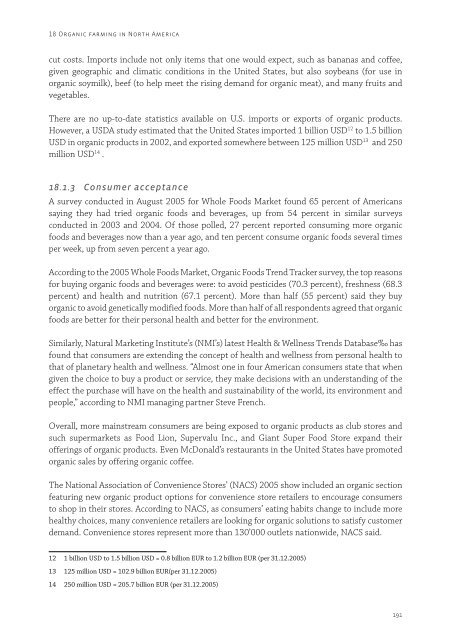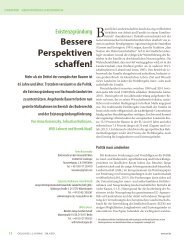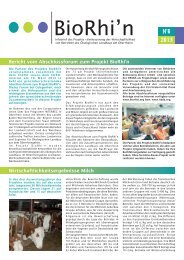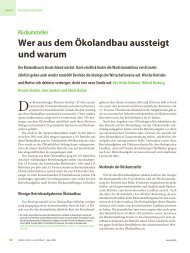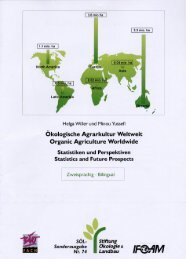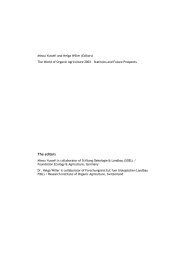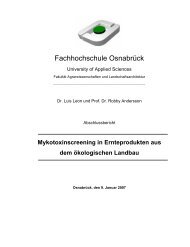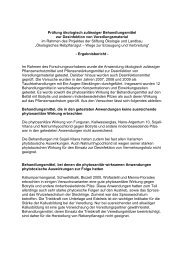the world of organic agriculture - Organic Eprints
the world of organic agriculture - Organic Eprints
the world of organic agriculture - Organic Eprints
You also want an ePaper? Increase the reach of your titles
YUMPU automatically turns print PDFs into web optimized ePapers that Google loves.
18 <strong>Organic</strong> farming in North America<br />
cut costs. Imports include not only items that one would expect, such as bananas and c<strong>of</strong>fee,<br />
given geographic and climatic conditions in <strong>the</strong> United States, but also soybeans (for use in<br />
<strong>organic</strong> soymilk), beef (to help meet <strong>the</strong> rising demand for <strong>organic</strong> meat), and many fruits and<br />
vegetables.<br />
There are no up-to-date statistics available on U.S. imports or exports <strong>of</strong> <strong>organic</strong> products.<br />
However, a USDA study estimated that <strong>the</strong> United States imported 1 billion USD 12 to 1.5 billion<br />
USD in <strong>organic</strong> products in 2002, and exported somewhere between 125 million USD 13 and 250<br />
million USD 14 .<br />
18.1.3 Consumer acceptance<br />
A survey conducted in August 2005 for Whole Foods Market found 65 percent <strong>of</strong> Americans<br />
saying <strong>the</strong>y had tried <strong>organic</strong> foods and beverages, up from 54 percent in similar surveys<br />
conducted in 2003 and 2004. Of those polled, 27 percent reported consuming more <strong>organic</strong><br />
foods and beverages now than a year ago, and ten percent consume <strong>organic</strong> foods several times<br />
per week, up from seven percent a year ago.<br />
According to <strong>the</strong> 2005 Whole Foods Market‚ <strong>Organic</strong> Foods Trend Tracker survey, <strong>the</strong> top reasons<br />
for buying <strong>organic</strong> foods and beverages were: to avoid pesticides (70.3 percent), freshness (68.3<br />
percent) and health and nutrition (67.1 percent). More than half (55 percent) said <strong>the</strong>y buy<br />
<strong>organic</strong> to avoid genetically modified foods. More than half <strong>of</strong> all respondents agreed that <strong>organic</strong><br />
foods are better for <strong>the</strong>ir personal health and better for <strong>the</strong> environment.<br />
Similarly, Natural Marketing Institute’s (NMI’s) latest Health & Wellness Trends Database‰ has<br />
found that consumers are extending <strong>the</strong> concept <strong>of</strong> health and wellness from personal health to<br />
that <strong>of</strong> planetary health and wellness. “Almost one in four American consumers state that when<br />
given <strong>the</strong> choice to buy a product or service, <strong>the</strong>y make decisions with an understanding <strong>of</strong> <strong>the</strong><br />
effect <strong>the</strong> purchase will have on <strong>the</strong> health and sustainability <strong>of</strong> <strong>the</strong> <strong>world</strong>, its environment and<br />
people,” according to NMI managing partner Steve French.<br />
Overall, more mainstream consumers are being exposed to <strong>organic</strong> products as club stores and<br />
such supermarkets as Food Lion, Supervalu Inc., and Giant Super Food Store expand <strong>the</strong>ir<br />
<strong>of</strong>ferings <strong>of</strong> <strong>organic</strong> products. Even McDonald’s restaurants in <strong>the</strong> United States have promoted<br />
<strong>organic</strong> sales by <strong>of</strong>fering <strong>organic</strong> c<strong>of</strong>fee.<br />
The National Association <strong>of</strong> Convenience Stores’ (NACS) 2005 show included an <strong>organic</strong> section<br />
featuring new <strong>organic</strong> product options for convenience store retailers to encourage consumers<br />
to shop in <strong>the</strong>ir stores. According to NACS, as consumers’ eating habits change to include more<br />
healthy choices, many convenience retailers are looking for <strong>organic</strong> solutions to satisfy customer<br />
demand. Convenience stores represent more than 130’000 outlets nationwide, NACS said.<br />
12 1 billion USD to 1.5 billion USD = 0.8 billion EUR to 1.2 billion EUR (per 31.12.2005)<br />
13 125 million USD = 102.9 billion EUR(per 31.12.2005)<br />
14 250 million USD = 205.7 billion EUR (per 31.12.2005)<br />
191


